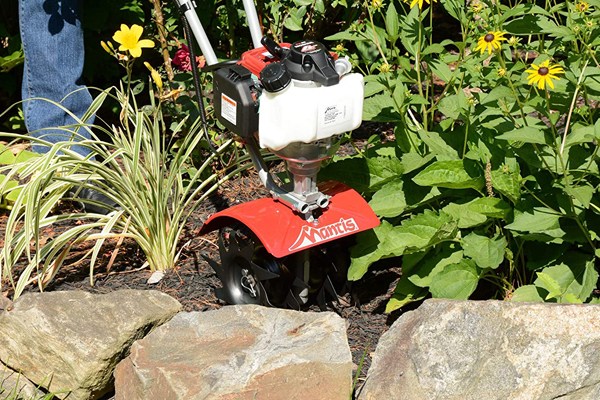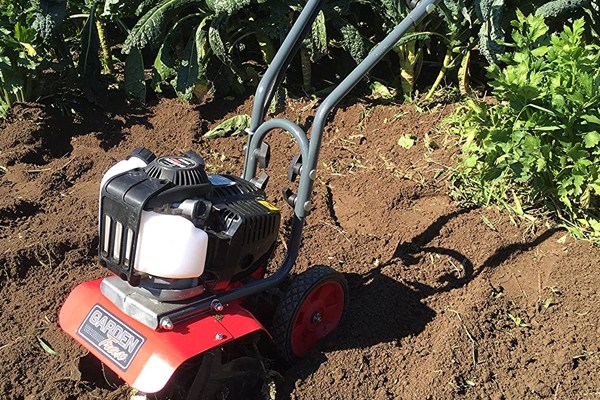Buying guide for best gas tillers
A quality gas tiller is a versatile tool that can turn a tired lawn into a productive vegetable plot, aerate your soil, make short work of weed growth, and quickly incorporate compost and fertilizer. They save hours of your valuable time and are way easier on your back than trying to dig over your ground by hand.
Two-cycle models are lightweight and deliver excellent performance from relatively modest capacities. Large four-cycle motors drive heavy-duty machines capable of tilling the biggest plots with minimal effort. No electric motor currently available comes close.
Far from being the difficult beasts of yesteryear, a raft of user-friendly features has made them infinitely more manageable and easier to live with. And while there's always an argument against the environmental impact of a gas motor, modern versions are more efficient than ever and many comply with stringent emissions standards.
To learn more, keep reading our guide. If you’re ready to buy, take a look at our recommendations, which cover a wide range of prices and performance options.
Key considerations
Motor
When you need consistent, reliable power delivery — and the freedom to cover large areas — there's no substitute for a gas motor. Two-cycle (also called two-stroke) gas tillers offer an excellent power-to-weight ratio and are easy to manage. While these modest-capacity motors can certainly be capable of creating new beds and borders from unbroken ground, you also need to look at tilling width and depth to get an overall picture of suitability. If you have hundreds or thousands of square feet to work, a large-capacity four-cycle motor will deliver more power and so won’t overstrain the engine. [Looking for more help in the garden? Check out our recommendations for garden fertilizers, gloves, and kneeler benches.]
Tilling width and depth
A greater tilling width means fewer passes over a given patch of ground — but it's nice to have adjustability so that you can narrow down the track for working in and around plants without disturbing them. Do you need this flexibility, or would you be better with a wide, fixed width that will help you turn over large plots faster?
A good tilling depth is useful for initial digging of new ground, but less important for maintenance tasks. It's usually set via a simple bar and cotter pin at the rear.
Front or rear tines
Front-tine machines have the tines mounted directly underneath the engine. The wheels (if fitted) are to the rear. These are usually smaller, lightweight machines, and most have variable width, making them easy to maneuver in tight spaces. Rear-tine machines have wheels at the front and large-diameter tines at the rear. These provide a track of as much as 26 inches wide for digging over large plots. However, many are not adjustable.
Drive
It’s the rotation of the tines that pulls the machine forward. Added versatility comes from dual rotating tines — so the machine can dig backward as well as forward. This is a feature only found on rear-tine tillers and is particularly good for breaking up heavily compacted or clay soils. Some large tillers provide a reverse gear that allows you to back up without actually digging. A few high-end tillers have multiple forward speeds, so you can run slowly when working new areas and speed up for turning existing plots.
Wheels and tires
Some lightweight gas tillers have no wheels. It's important not to run these across hard surfaces like tarmac, because you'll bend the tines. Mid-range models have wheels with solid tires. The largest have pneumatic tires, which make them easier to steer over uneven terrain. Some rear-tine models also have counterweights on the front to improve overall balance and make a big machine easier to handle.
Safety
We came across a couple of four-cycle models that have a low–oil pressure shut-off, a valuable safety feature that stops the engine before lack of oil can do any damage.
Storage
Front-tine tillers often have fold-down handles so you need little space to store them. Unfortunately, rear-tine tillers are just big — but if you've got a yard large enough to warrant one, you've probably got a substantial shed or barn to keep it in.
Two types of tires are found on gas tillers: solid tires, which tend to be found on small tillers, and mid-level tires, which tend to be pneumatic and used on large, powerful machines. We look at both types in our research.
A tiller must be able to slice through the earth to prepare it for planting. We take this into account, assessing the tilling depth of each contender.
We think about the pros and cons of two-cycle and four-cycle motors in our research. The motor of a gas-powered tiller impacts its performance and the type of gardening tasks it can handle.
In our research of gas tillers, we want to know if a machine has front or rear tines. We include information about the capabilities of each type of tine configuration.
When we evaluate gas tillers, we look to see if they offer multiple speeds and a reverse gear. These features are commonly found on tillers with rear tines and are recommended for tilling tough soil and large pieces of land.
We understand that some consumers want a small gas tiller for basic gardening needs. When comparing models, we note that front-tine tillers are compact and easier to operate than their rear-tine competitors.
When we examine a tiller, we determine its tilling width and whether that width is adjustable.
Some gas-fed tillers have a shutoff function that kicks in if the machine runs low on oil. We check to see if this feature is offered when we do our evaluations.
Our research of gas tillers includes evaluating how easy each machine is to operate and maneuver.
We take note of the quality and length of the warranty offered for each gas tiller on our research list.
Gas tiller prices
Inexpensive: Entry-level tiller/cultivators start at, or just below $200. You'll get 20 to 50cc two-cycle engines capable of handling aerating and weeding tasks but that don't have the outright power for a lot of ground breaking.
Mid-range: The medium-sized tillers that are the ideal all-round solution for most gardeners cost between $250 and $350. This will give you a choice of two- or four-cycle machines and cutting widths of around nine to 12 inches.
Expensive: Powerful four-cycle machines that can handle substantial plots cost $500 and up. You can pay $1,400 or more for electric start models and up to $2,500 for the largest models — but these are rated for yards of several thousand square feet.
Maintenance tips
Tiller maintenance is not difficult, and a little care will extend the working life of your tool.
Don't put your tiller away dirty. Remove tangled weeds or roots and wash it down.
Check the tines. Although they don't need to be razor-sharp, if there's damage or they're worn, a quick rub over with a file can make a big difference to digging performance.
Engine maintenance will vary depending on whether it's a two-cycle or four-cycle motor. Follow the manufacturer’s instructions for recommended air, fuel, or oil and oil filter changes.
If starting is difficult, check the spark plug. If it's dirty, give it a quick scrub with a wire brush. If it's cracked, chipped, or burned, it will need replacing.
Check drive belts for wear and replace if necessary.
If you've got pneumatic tires, check air pressures.
Check nuts, bolts, and other fasteners are done up tight. These machines do vibrate a bit, and they can work loose.
Other products we considered
Most of our recommendations focus on tillers for small to medium-sized gardens, but we also looked at a few high-power models for larger yards.
Many tillers with large four-cycle engines are rear-tine models, but the 212cc Champion 22-Inch Tiller is a front-tine model that combines 16- to 22-inch tilling width with dual rotation to make it easier to break up tough ground.
The Yardmax YT4565 is another dual rotating model, this time rear-tined. It sports the popular and reliable 208cc Briggs & Stratton motor. Tilling width is 18 inches, though it's not adjustable.
The Troy-Bilt Pony ES has a 250cc Briggs & Stratton engine. This machine with a 16-inch tilling width is one of a few that offers an electric start.
FAQ
Q. Are two-cycle (two-stroke) motors legal in California?
A. Two-cycle motors tend to have higher emissions than four-cycle models, but as far as we know, there's no particular ban on gas-powered garden tools. If you're concerned, check that the motor is CARB (California Air Resources Board) compliant. Fifteen states have now adopted this standard.
Q. Is a front-tine tiller better than a rear-tine version?
A. It's really a question of the type of work you'll be doing most of the time. Rear-tine tillers are usually big, powerful (and relatively expensive) machines designed for initial creation of a plot or the annual cultivation of large, unplanted areas. They aren't so good at maintenance work in and around existing planting. In those situations, a front-tine tiller provides the greater maneuverability you need.
Q. What's the difference between a tiller and a cultivator?
A. Landscape professionals look at a tiller as a machine capable of digging through clay or stony or compacted soil in order to create new planting areas, whereas a cultivator is only used for reworking an existing bed. With consumer models, the difference has become blurred, and tiller/cultivators are dual-purpose machines capable of performing both tasks. However, if it's just called a cultivator, don't expect it to break new ground.





















































